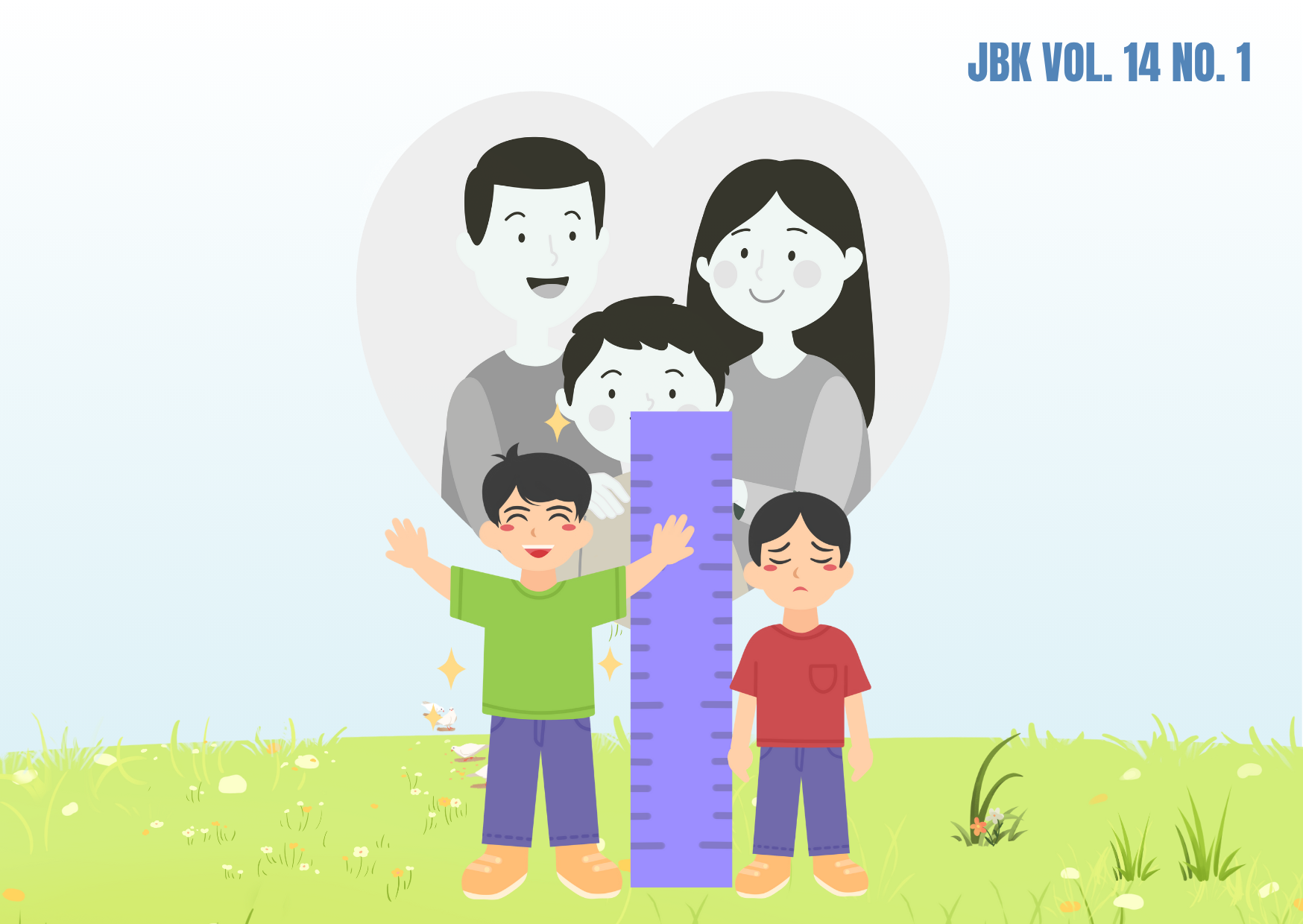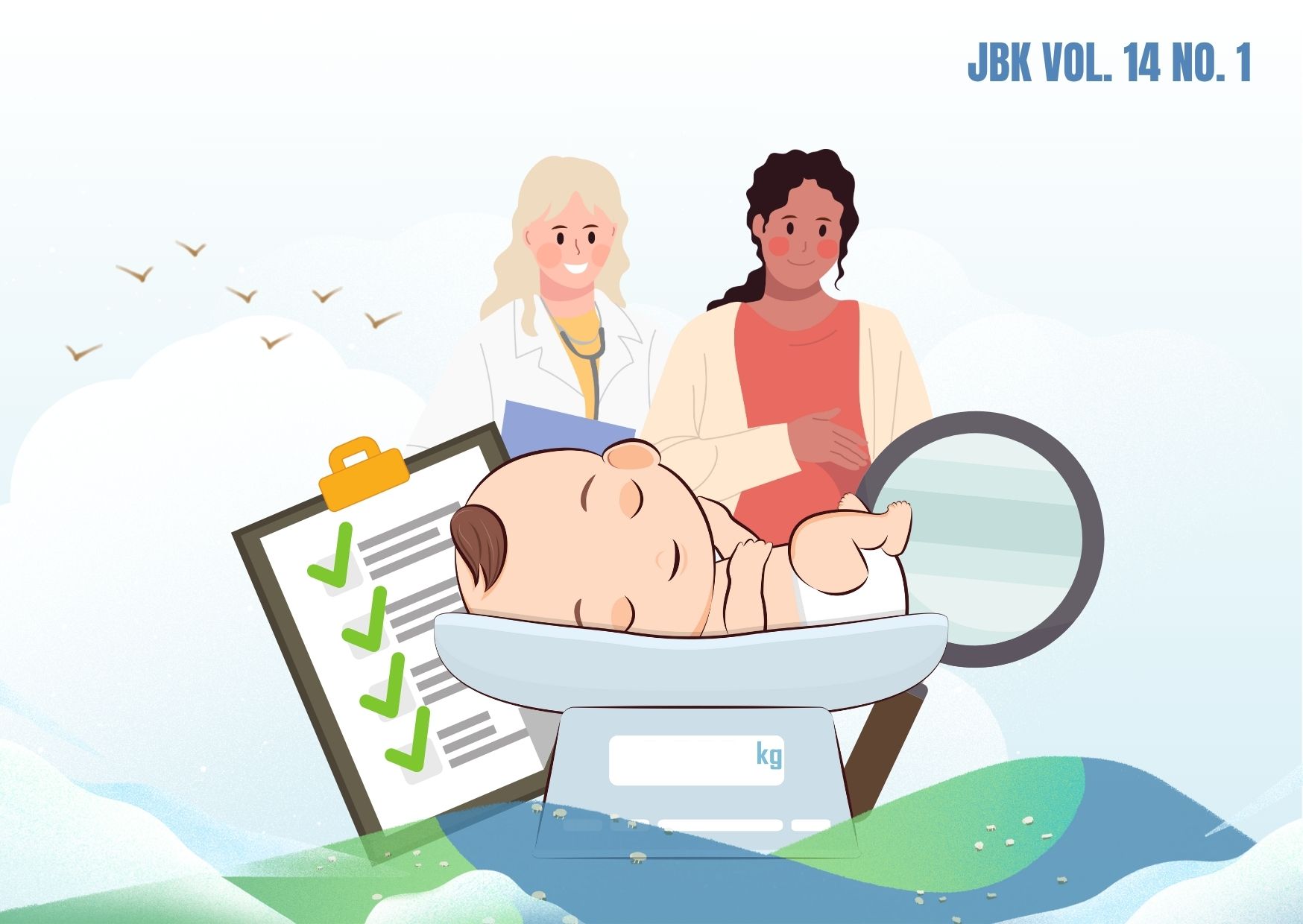IRON-RICH FOOD CONSUMPTION AND ASSOCIATED FACTORS AMONG CHILDREN AGED 6-23 MONTHS: A FURTHER ANALYSIS OF 2017 INDONESIA DEMOGRAPHIC AND HEALTH SURVEYS
Downloads
Iron deficiency in children age under two years are potentially to get a higher risk of iron deficiency anemia. This research seeks to examine the factors that influencing the consumption of iron-rich food among aged group 6-23 months in Indonesia. This research utilized a cross-sectional design and was conducted through a secondary analysis of 2017 Indonesia Demographic Health Survey (IDHS) data, involving a total weighted sample of 4.622 children aged group 6-23 months. The process of analysis data using a computer program. The statistical test used for bivariable analysis is the chi-square test and multivariable analysis uses the logistic regression test. Overall, 71.7% of children aged group 6-23 months in Indonesia exhibited a strong level of consumption of iron-rich foods. Children with aged 18-23 months [aPR= 8.42; 95%CI= 6.61-10.72], highly educated mothers [aPR= 1.14; 95%CI= 1.01-1.98], antenatal care visits <6 times [aPR= 1.77; 95%CI= 1.04-3.02], who took medication for deworming and antiparasitic over the past 6 months [aPR= 1.55; 95%CI= 1.17-2.05], children who were not breastfeeding [aPR= 1.36; 95%CI= 1.10-1.68], relatively rich economic status [aPR= 1.43; 95%CI= 1.11-1.82] and mothers who access of mass media [aPR= 1.40; 95%CI= 1.17-1.68] has a statistically significant with the good consumption of iron-rich foods in children aged 6-23 months in Indonesia. The interventions must have been focused on nutrition education, access to antenatal care (ANC), encouraging health promotion through mass media and support efforts from government to improving socioeconomic factors are needed for increase the consumption of iron-rich foods in children.
Afifah CAN, Ruhana A, Dini CY, Pratama SA. Buku Ajar Gizi dalam Daur Kehidupan. Yogyakarta: Deepublish; 2022. 1–186 p.
Zheng J, Liu J, Yang W. Association of Iron-Deficiency Anemia and Non-Iron-Deficiency Anemia with Neuro-behavioral Development in Children Aged 6–24 Months. Nutrients. 2021;13(10):1–11. Available from: https://doi.org/10.3390/nu13103423
WHO. Prevalence of Anaemia in Children Aged 6–59 Months (%) [Internet]. [cited 2024 Feb 10]. Available from: https://www.who.int/data/gho/data/indicators/indicatordetails/GHO/prevalence-of-anae-mia-in-children-under-5-years-(-)
Pivina L, Semenova Y, Doşa MD, Dauletyarova M, Bjørklund G. Iron Deficiency, Cognitive Functions, and Neurobehavioral Disorders in Children. J Mol Neurosci. 2019 May;68(1) :1-10. Available from: https://link.springer.com/article/10.1007/s12031-019-01276-1
Pasricha S, Tye-din J, Muckenthaler MU, Swinkels DW. Seminar Iron Deficiency. The Lancet. 2020;6736(20):1–16. Available from: http://dx.doi.org/10.1016/S0140-6736(20)32594-0
Piskin E, Cianciosi D, Gulec S, Tomas M, Capanoglu E. Iron Absorption: Factors, Limitations, and Improvement Methods. ACS Omega. 2022;7(24):20441–56. Available from: https://doi.org/-10.1021/acsomega.2c01833
Atkins LA, Spence AC, Szymlek-Gay EA. Iron Nutrition of Pre-Schoolers in High-Income Count-ries: A Review. Nutrients. 2023;15(11). Available from: https://doi.org/10.3390/nu15112616
Majestika Septikasari. Status Gizi Anak dan Faktor yang Mem-pengaruhi. Yogyakarta: UNY Press; 2018. 1–74 p.
Akpaki K, Galibois I, Blaney S. Feeding Practices and Factors Associated with The Provision of Iron-Rich Foods to Children Aged 6-23 Months in Matam
Area, Senegal. Public Health Nutrition. 2021;24(14):4442–53. Available from: https://doi.org/10.1017/S1368980021002718
Aurora WID. Efek Pemberian Zat Besi Tambahan pada Anak. JMJ. 2021;9(2):199–203. Available from: https://doi.org/10.22437/jmj.v9i1.13122
Croft, Trevor N, Aileen M, Mrshall J, Courtney K, Allen K. Guide to DHS Statistics (DHS-7). USAID. 2018. 1–90 p.
Akalu Y, Yeshaw Y, Tesema GA, Demissie GD, Molla MD, Muche A, et al. Iron-Rich Food Consumption and Associated Factors Among Children Aged 6-23 Months in Sub-Saharan Africa: A Multilevel Analysis of Demographic and Health Surveys. PLoS ONE. 2021;16(6 June):1–16. Available from: http://dx.doi.org/10.1371/journal.pone.0253221
Ministry of Health of the Republic of Indonesia. Pedoman Pelayanan Antenatal Terpadu 2020 Ed.3 [Internet]. Vol. III, Kementerian Kesehatan Republik Indonesia. 2020. 4–6 p. Available from: https://repository.kemkes.go.id/book/147
Asresie MB, Fekadu GA, Dagnew GW. Determinants of Anemia Among Children Aged 6–59 Months in Ethiopia: Further Analysis of the 2016 Ethiopian Demographic Health Survey. Hindawi. 2020;21(1):1–6. Available from: https://doi.org/10.1155/2020/3634591
Hamza HA, Oumer A, Kabthymer RH, Ali Y, Mohammed AA, Shaka MF, et al. Individual and Community-Level Factors Asso-ciated with Animal Source Food Consumption Among Children Aged 6-23 Months in Ethiopia: Multilevel Mixed Effects Logistic Regression Model. PLoS ONE. 2022;17(4 April). Available from: http://dx.doi.org/10.1371/journal.po-ne.0265899
Liu J, Huo J, Liu Z, Sun J, Huang J. Prevalence and Temporal Trend (2016–2018) of Anaemia Among 6–23‐Month‐Old Infants and Young Children in China. International Journal of Environmental Research and Public Health. 2021;18(4):1–9. Available from: https://doi.org/10.3390/ijerph1804041
Fançony C, Soares Â, Lavinha J, Barros H, Brito M. Iron Deficiency Anaemia Among 6-to-36-Month Children from Northern Angola. BMC Pediatrics. 2020;20(1):1–13. Available from: https://doi.org/10.1186/s12887-020-02185-8
Semagn BE, Gebreegziabher ZA, Abebaw WA. Iron-Rich Food Consumption and Associated Factors Among Children Aged 6–23 Months in Sierra Leone: Multi-Level Logistic Regression Analysis. BMC Public Health. 2023;23(1):1–10. Available from: https://doi.org/10.1186/s128-89-023-16737-x
Shenton LM, Jones AD, Wilson ML. Factors Associated with Anemia Status Among Children Aged 6–59 months in Ghana, 2003–2014. Maternal and Child Health Journal. 2020;24(4):483–502. Available from: https://doi.org/10.1007/s10-995-019-02865-7
Agrawal S, Kim R, Gausman J, Sharma S, Sankar R, Joe W, et al. Socio-Economic Patterning of Food Consumption and Dietary Diversity Among Indian Children: Evidence From NFHS-4. European Journal of Clinical Nutrition. 2019;73(10): 1361–72. Available from: https://doi.org/10.10-38/s41430-019-0406-0
Tiruneh SA, Ayele BA, Yitbarek GY, Asnakew DT, Engidaw MT, Gebremariam AD. Spatial Distribution of Iron Rich Foods Consumption and Its Associated Factors Among Children Aged 6-23 Months in Ethiopia: Spatial and Multilevel Analysis of 2016 Ethiopian Demographic and Health Survey. Nutrition Journal. 2020;19(1):1–13. Available from: https://doi.org/10.1186/s12937-020-00635-8
Gebretsadik GG, Tadesse Z, Ambese TY, Mulugeta A. Trends in and Predictors of Animal Source Food Consumption Among 6–23 Months Age Children in Tigrai, Northern Ethiopia: Evidence from Three Consecutive Ethiopian Demographic and Health Surveys, EDHS 2005–2016. BMC Nutrition. 2023;9(1):1–9. Available from: https://doi.org/10.1186/s40795-023-00699-9
Dhami MV, Ogbo FA, Osuagwu UL, Agho KE. Prevalence and Factors Associated with Complementary Feeding Practices Among Children Aged 6 – 23 months in India: A Regional Analysis. BMC Public Health. 2019;19(1034):1–16. Available from: https://doi.org/10.1186/s12889-019-7360-6
Eshetu HB, Diress M, Belay DG, Seid MA, Chilot D, Sinamaw D, et al. Individual and Community-Level Factors Associated with Iron-Rich Food Consumption Among Children Aged 6–23 Months in Rwanda: A Multilevel Analysis of Rwanda Demographic and Health Survey. PLoS ONE. 2023;18(1 January):1–14. Available from: http://dx.doi.org/10.1371/journal.pone.0280466
Dhawan D, Pinnamaneni R, Viswanath K. Association between Mass Media Exposure and Infant and Young Child Feeding Practices in India: A Cross-Sectional Study. Scientific Reports. 2023;13(1):1–11. Available from: https://doi.org/10.1038/s41598-023-46734-4
Dafursa K, Gebremedhin S. Dietary Diversity among Children Aged 6-23 Months in Aleta Wondo District, Southern Ethiopia. Journal of Nutrition and Metabolism. 2019. Available from: https://doi.org/10.1155/2019/2869424
Adedokun ST, Yaya S. Factors Associated with Adverse Nutritional Status of Children in Sub-Saharan Africa: Evidence from The Demographic and Health Surveys from 31 countries. Maternal and Child Nutrition. 2021;17(3):1–10. Available from: https://doi.org/10.1111/mcn.13198
Akpaki K, Galibois I, Sall M, Blaney S. Assessing The Food Availability and Food Insecurity Situation among Communities of Matam Region, Senegal. Ecology of Food and Nutrition. 2020;59(4):367–86. Available from: https://doi.org/10.1080/03670244.2020.1733993
Sunuwar D, Singh D, Man P, Pradhan S, Shrestha V, Rai P. Factors Associated with Anemia Among Children in South and Southeast Asia: A Multilevel Analysis. BMC Public Health. 2023;23(343):1–17. Available from: https://bmcpublichealth.biomedcentral.com/articles/10.1186/s12889-023-15265-y
Copyright (c) 2024 Jurnal Biometrika dan Kependudukan (Journal of Biometrics and Population)

This work is licensed under a Creative Commons Attribution-NonCommercial-ShareAlike 4.0 International License.
Copyright©2022 Jurnal Biometrika dan Kependudukan (Journal of Biometrics and Population)
This work is licensed under a Creative Commons Attribution-NonCommercial-ShareAlike 4.0 International License.
1. Copyright of all journal manuscripts is held by the Jurnal Biometrika dan Kependudukan.
2. Formal legal provisions to access digital articles of the electronic journals are subject to the provision of the Creative Commons Attribution-ShareAlike license (CC BY-NC-SA), which means that Jurnal Kesehatan Biometrika dan Kependudukan to keep, transfer media/format, manage in the form of databases, maintain, and publish articles.
3. Published manuscripts both printed and electronic are open access for educational, research, and library purposes. Additionally, the editorial board is not responsible for any violations of copyright law.



































